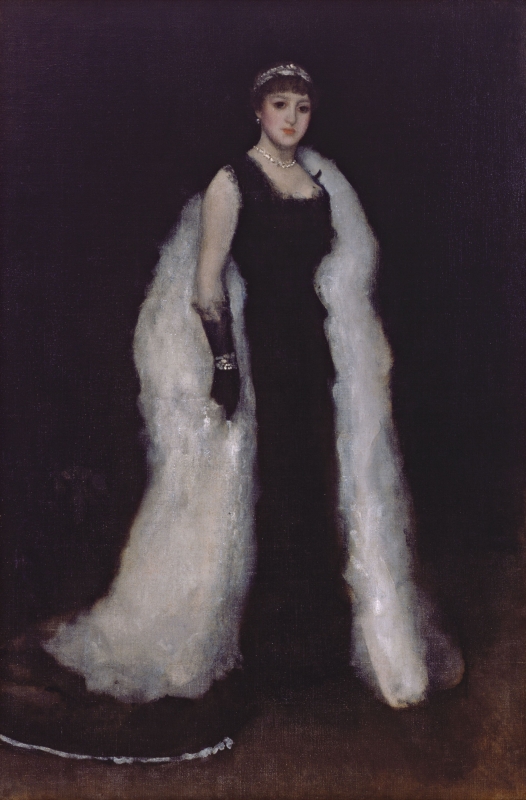Home > Catalogue > People > Alan Summerly Cole (related works) > Catalogue entry
Composition
There are two pen drawings by Whistler that relate to Arrangement in Black: Lady Meux [YMSM 228], namely Study for 'Arrangement in Black: Lady Meux' [M.0850] and Arrangement in Black - No. 3 [M.0851] (which was inscribed by Whistler with that title). They date from 1881 and show only minor variations in the composition. The first shows Lady Meux as rather more slender than in the oil, and wearing a glove, which she does in the oil. The other drawing, Arrangement in Black – No. 3, suggests a more slender, curving, shape for the dress, and clearly shows the skirt trailing out behind her at left.
Technique
The canvas is approximately the size of the French 'toile de 120' (195 x 130cm) and may have been acquired in Paris. According to T. R. Way, Whistler found 'great difficulty in getting canvas to his liking' for the portraits of Lady Meux, and was 'very critical' of Arrangement in Black: Lady Meux, because in it he had departed from his usual practice, and carried out 'some slight painting upon her arm after it had dried.' 1
Mrs Julian Hawthorne saw Lady Meux posing;
'I once had the exhilarating experience of seeing Whistler paint a portrait. The subject was a very beautiful woman, of a sumptuous type ... On his left was the easel, supporting the tall canvas; beyond, at a distance of some twenty feet, stood the "sitter", on a dais, with her splendid furtrimmed cloak falling off her white shoulders. This side [of the easel], still more to the left, was a table as large as a five-o'clock tea-tray, the top of which consisted of a palette, fixed at a slight inclination. Whistler held in his left hand a sheaf of brushes, with monstrous long handles; in his right the brush he was at the moment using. His movements were those of a duellist fencing actively and cautiously with the small sword ... He advanced and retreated; he crouched, peering; he lifted himself, catching a swift impression; in a moment he had touched the canvas with his weapon and taken his distance once more. This would go on for an hour or two, most of it in silence ... I watched this operation day after day for a week or more.' 2
Whistler's biographer's, the Pennells, comment:
'M. Duret, who often saw the portrait in the studio, found in it something "mysterious and fantastic"; to us, the firm modelling of the face and beautiful bare neck and arms, gives to the almost regal figure more solidity than Whistler usually tried for, and less of the spirit, the phantom, that Desnoyers, and Huysmans after him, found in Whistler's paintings of women.' 3
Conservation History
Before the Salon exhibition in Paris in 1882, Whistler told George Aloysius Lucas (1824-1909):
'I was foolish enough to varnish the picture just before it went - so that what with the damp weather and the crossing, I fancy that it will have "bloomed" - so that the transparency of the back ground will have for the moment been lost - and a nasty blue sort of breath be over the whole thing -
Tell Goupil to gently rub it over with an old soft silk handkerchief until the polish comes back - and by and bye when in the Salon - the day before the opening they are to give the whole picture a splendid coat of varnish.' 4
Similarly, he wrote to Charles Ephrussi (1849-1905):
'… la toile même pourrait se trouver dans une mauvaise condition - vu que je l'avais mal vernis et par ce temps humide le vernis a pu se couvrir de ce que nous appellons en Anglais "bloom" - c'est à dire une espèce de buée bleuâtre qui détruit pour le moment la transparence du fond.' 5
Translation: '... the canvas could be found in bad condition - since I varnished it badly and in this humid weather the varnish could have been covered in what we call "bloom" in English - that is a kind of bluish bloom which can temporarily destroy the transparency of the background.'
Frame
In 1882, when he sent the portrait to the Salon, Whistler mentioned to Charles Ephrussi, 'J[e] crains un peu pour le cadre qui a été fraichement peint' ('I am a little concerned about the frame which has been freshly painted'). 6 He also begged G. A. Lucas for his help with the frame:
'Now I want you to especially see to this for me - The frame requires a tablet gilded of course with my name upon it after the French fashion nailed over the name I have painted - and longer so that it will come in the proper centre - You will see that I have it a little to one side -
You know the kind of thing I mean - something like this WHISTLER.' 7
The present Portrait Whistler frame may have been added for exhibition in 1892/1893. 8
Notes:
1: Way 1912 [more] , pp. 137, 71.
2: Hawthorne 1881 [more] , at p. 658.
3: Pennell 1908 [more] , vol. 1, p. 301.
4: [23 March 1882], GUW #09205. Similarly, Whistler asked Théodore Duret (1838-1927) to check on the painting, [23/25 March 1882], formerly dated [March/April 1882], GUW #09639.
5: Whistler to C. Ephrussi, [23/25 March 1882], formerly dated [March/April 1882], GUW #09077.
7: [23 March 1882], GUW #09205.
8: Dr Sarah L. Parkerson Day, Report on frames, 2017.
Last updated: 17th November 2020 by Margaret









